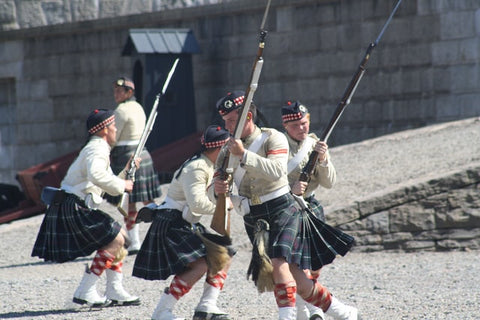Did you know that April 6th is Tartan Day? Marking the anniversary of the signing of the Declaration of Arbroath, Tartan Day is a celebration of Scottish heritage which originated in Canada, and is now observed in the USA and around the world. To mark the occasion, in this blog post we’re exploring the history of tartan from Roman Britain to the modern day!
What is tartan?
Often called ‘plaid’ in the US (a term deriving from the Gaelic word for a blanket), tartan is a patterned fabric formed of interlocking coloured stripes running both up and down and to the left and right of the cloth (warp and weft), known as a sett. The term can also refer to the representation of this checked style of pattern in other media.

Does tartan originate in Scotland?
Although tartan fabric has become synonymous in the popular imagination with Scottish heritage, tartan-style fabric has been found throughout the world, including in ancient archaeological sites in central Europe, and intriguingly, on the mummy of a man whose DNA was of European origin in a Bronze Age tomb in western China, suggesting ancient trade routes and ties between east and west.
The earliest surviving form of tartan fabric discovered in Britain was unearthed in Falkirk, Stirlingshire, and dates from the 3rd Century AD. Featuring a simple check design believed to have been invented by the native peoples of the British isles, it was stuffed into the mouth of a pot containing over 2,000 Roman coins, and buried around 230 AD.

When did tartans become associated with specific clans?
The connection of tartans to specific clans or families is a relatively modern invention in the history of the fabric, which is documented as being particularly popular in the Highland dress by the seventeenth century. With all tartan hand woven and produced using local, natural dyes, distinctive patterns or setts became loosely linked with the weavers of different regions and islands, rather than with specific families, and highlanders would often combine several different tartan patterns in their dress.
By the eighteenth century, tartan cloth had become closely connected to Highland culture, and by the middle of the 1700s, so closely linked to the Jacobite cause that, after the Battle of Culloden in 1746, the British government banned the wearing of tartan in the Act of Proscription, except for those of the Highland regiments of the British army.

The Act was eventually repealed in 1782, by which point the skills and knowledge of a generation of weavers had been largely lost, and the large-scale production of tartan was taken up by commercial weavers, such as William Wilson & Sons of Bannockburn. The sole supplier of tartan to the British Highland regiments, from 1810 to 1820, Wilson sought to gather samples of cloth from the Highlands, eventually collecting over 200 patterns that are now held in the Mitchell Library in Glasgow. Initially each pattern was assigned a number to differentiate it from others, but later Wilson & Sons began to assign them names, including those of places, towns, and those of Highland clans.
Perhaps because of this, the idea began to form that individual tartans were representative of specific clans. When George IV visited Edinburgh in 1822 (the first royal visit of a reigning monarch in over 170 years), it was suggested that clan chiefs attend the festivities organised by Sir Walter Scott to mark the occasion in their ‘proper tartan’ - leading some to hurriedly invent them! Following the visit, several books were published documenting tartans, leading to something of a ‘tartan craze’ that was further intensified by the enthusiasm with which Queen Victoria embraced the fabric.

Despite this royal seal of approval, tartan has, however, never quite lost its rebellious allure, and has been adopted by Punk and youth counter-cultures around the globe, alongside fashion designers such as Vivienne Westwood and Alexander McQueen. Today, all patterns must be registered with the Scottish Register of Tartans in Edinburgh, with patterns not only named for individual clans, but also countries such as Jamaica, and by the much-loved character Hello Kitty, demonstrating the enduring appeal of this ancient fabric.
Enjoying our blog posts? Join our mailing list to receive every new post straight to your inbox!









